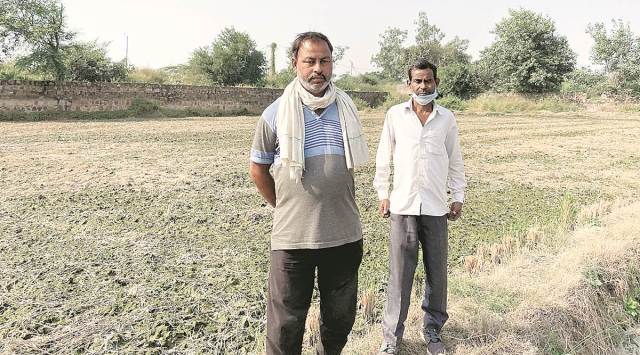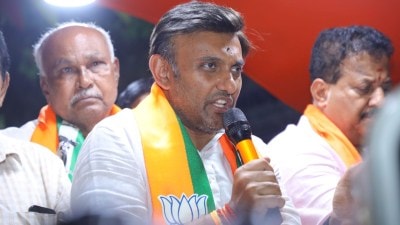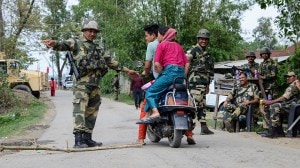- India
- International
In trial run, Delhi farmers see hope in PUSA stubble control tech
Trial of this technology on about 800 hectares of field in Delhi was inaugurated by Chief Minister Arvind Kejriwal at Prakash's farm on October 13.
 Umesh (left) with his cousin.
Umesh (left) with his cousin. Umesh Singh (42) examined a few paddy straws at his brother Prakash’s field in North Delhi’s Hiranki village on Tuesday afternoon. He crushed a few of them in his palm with ease. “Usually, the straw is very stiff, it doesn’t break apart easily. The straws at this field have decomposed about 90% and would be easier to mix with soil. Wheat can be sowed here in about a week from now.”
Singh then walked over to his field across the road, picked up a few straws and tried to crush them. “These straws still require some effort. They will decompose in about a month,” he said.
The difference between Singh’s field and his brother’s field is that Prakash had the ‘Pusa decomposer’ solution sprayed about two weeks ago for managing crop residue — a fungi-based technology developed by the Indian Agricultural Research Institute (IARI).
Trial of this technology on about 800 hectares of field in Delhi was inaugurated by Chief Minister Arvind Kejriwal at Prakash’s farm on October 13.
Singh, on the other hand, decided to flood his field with water to try and decompose the stubble, a method he and Prakash had been following since the past few years. “But the stubble at my field is just as it was 15 days ago,” Singh said on Tuesday.

Burning of paddy stubble, a practice usually followed by farmers in Punjab, Haryana and Uttar Pradesh to quickly clear their fields before planting wheat crop, contributes to air pollution in the northern Gangetic plains and its already polluted cities like Delhi at the start of winter.
Efforts to stop the practice through use of machines that provide an alternative solution for stubble management have so far been unsuccessful, despite 50% to 80% subsidy provided to farmers in Punjab and Haryana on these machines.
The ‘Pusa Decomposer’ costs Rs 20 for a pack of four capsules, which can be mixed water, 150 grams of jaggery and 50 grams of besan, to develop a 25-litre solution for 1 hectare of field.
IARI director Dr A K Singh said the solution contains enzymes that helps decompose the stubble fibre in about 15-20 days, which can then be mixed with soil in the field to act as compost before planting the next crop. “Even if some straws are seen on the fields after 15-20 days, they are soft enough to be easily broken and mixed in the field. It’s the hard straws that create a problem,” he said. Burning the straw harms the soil, Dr Singh said, killing essential microbes in it and also causing pollution.
With the use of this technology, nutrients released from the decomposed stubble will be beneficial for the soil, which will improve its quality, Dr Singh added.
Back at Hiranki village, Prakash’s son Sumit Singh (24) said the technology works: “The stubble has decomposed, we will start sowing wheat in about a week from now. This is profitable for us because we didn’t have to take the stubble anywhere… Earlier, when we used to flood the field with water to decompose the stubble, it would take a long time.”
Umesh said that the solution would save his brother at least 12 litres of diesel, as instead of using a Rotavator machine three different times to prepare the field for planting the next crop, it would have to be used just once, since the stubble is soft enough.
He also said they might require fewer bags of fertilisers as the decomposed straw would act as compost. “The technology has helped in faster decomposition of stubble, but the next thing we will be watching is the productivity of soil… This will depend upon the quality of our next wheat crop,” Umesh said.
Apr 27: Latest News
- 01
- 02
- 03
- 04
- 05








































